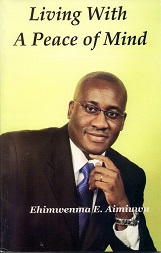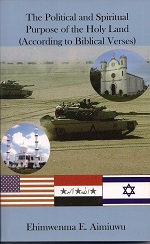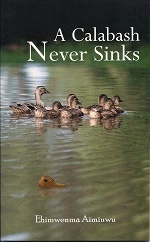
The success of Idu society may have been due in part to their belief that the sin of one of them affects the fortunes of every one else in the society. Every member of the society pays for Emose’s greed and must attempt to atone for it and cleanse it by working together with others as one family. I don’t know if this was unique to Idu society but it ensured that everyone was everyone else’s keeper. They looked out for the welfare of the others and so created a large family of achievers and an extended family that worked like one mind.
To the Idu people, Obo (hand) is human’s principal means of fulfillment, achievement and power. It symbolizes his ability and willingness to tame his environment, and supports the notion of reciprocity. A clenched fist, the Bini say, cannot take more than it is holding. To reap profit and abundance, one must be prepared to give or let go. They believed that events on earth move in cycles and that one should live for the benefit of other things. These are the critical concepts that helped Idu society to achieve the tremendous level of social sophistication, civilization and excellence in the arts, administration, conquests and social engineering envied today by modern society.


Man in Idu
society was not perceived as a loner but as a member of a vibrant
group with his or her individual uniqueness in skills and expertise
recognized and encouraged to flourish. The Idu person was expected
to contribute his or her individual uniqueness in talents, knowledge
and skills to help build, sustain, and enhance the quality of life
of the family, community and society. Obligations and activities
were performed generally through age grade groups and guilds.
Solidarity to the whole was emphasized above individual rights and
loyalties, thereby encouraging the individual involved to develop a
sense of duty and obligation to live, work, and if necessary die for
the group or community. Broadly, while the junior age grades
performed basic or elementary tasks such as clearing paths, caring
for public buildings, middle grades adult males handled the more
difficult tasks of roofing houses and administrative and executive
functions for the community councils.
Even the Idu nuclear family was not restricted to the husband, wife and child notion. It embraced an expanding cycle of cousins, uncles, aunts, nieces, nephews, grand parents, grand uncles, grand aunts and so on. There was usually a head or father figure or ultimate authority known as Okaegbee, recognized by all, and whose words were final in family matters. He was not a dictator, but arrived at decisions through exhaustive consultation, counseling and when necessary, divination. Most times, he was the oldest on the extended family tree and old age was generally considered to be synonymous with wisdom.
In the same way that each extended family had an Okaegbee, or leader, each ward community, village, town, dukedom, had an Odionwere, who more often than not was the oldest person in the society. The community, village, town, or dukedom, organized itself into Otu (age) groups and guilds. Each Otu had seven divisions. The idea of seven started when a group of seven, known as the ‘Ominigie,’ was set up during the Ogiso era. Ominigie was a militant or warrior group that went to war for the society. According to myths, the group accompanied their war activities with music and dance and when they were eventually vanquished, it was said that they danced their way to heaven. Another group of seven was promptly set up after their demise and the rhythm of seven has prevailed since.
Each of the seven divisions of the Otu (age groups) represents special ethos translating roughly as follows:
(a) Vigilance
(b) Oba’s tax collectors
(c) Community publicity officers
(d) Task masters or enforcers
(e) Self help gurus
(f) Pacifiers/judges
(g) Enforcers of loyalty and patriotism to the land and kingdom.
Otu age groups divide as follows: 5 – 15 (Emwin-rhoba-evbo); 16 – 30 (Eroghae); 30 – 50 (Eghele); 50+ (Odion). The oldest male in the community was on his own and was known as the Odionwere. Membership of each group was for life and group members moved into new age groups together. Elevation into the 50+ age group was only by merit, based on a measurable quality of character, achievement, and demonstrable level of wisdom. Therefore, a child who is hard working and precautious could move through the ranks to meet his father. Only one person moves from Odion to Odionwere (leader of the society or community), when the Odionwere’s position is vacant.
Such newly promoted Odionwere, who usually is the oldest person in the community, appoints two new Odions on merit to do the administration and running around for him because of his old age. The same scenario is repeated in the Otu groups that bring neighbouring villages, towns, dukedoms and communities together. Their special responsibilities at the inter community level include military and security services, administering spiritual needs, serving as think tanks and as apex groups known as the Elders Council. Beyond the Elders council is the Enogie, who principally is the head Chief of the group of communities, and is appointed by the Oba who he represents. The title of Enogie entitles the holder to wear coral beads.
Parallel with the Otu groups, which are largely concerned with administrative and security matters, are the guilds. The guilds are set up around professions, and are more or less like modern day trade unions, with a leader or head who is a chief and is appointed by the Oba. The guilds represent all facets of human endeavours. The Iwowa guild, for instance, is led by Chief Ogua and is responsible specifically for the digging of the underground burial chambers of a transited Oba. The Iwowa group is a branch of the Ihogbe, the monarch’s family group that takes care of his ancestral shrine, which includes the original Idu deity, and represents the ancestors of the kings.
Other guilds included the goldsmiths, brass smiths and black smiths; olopa (police); public health workers (including medical personnel, and nurses); warriors and peace maintenance or security; market men and women; sewers (fashion designers/producers, weavers); variety of sporting and games groups (such as wrestlers, chess players); farmers; wood carvers, ivory carvers; town criers; barbers; spiritual leaders (such as ‘Obo,’ oguega, (diviners); artistes (drummers, theatrical groups, singers, dancers, clowns, jesters, story tellers); builders, interior decorators etc; Each group lived largely in a specially designated section of town and had its own chiefs appointed by the Oba, and its festivals.
Idu people had days for work, play and rest. They observed a four day week, the fourth day, called ‘eken,’ was the rest day, and was reserved for sporting activities, games and all sorts of community programmes. They adopted the lunar calendar of 13 months in a year and 28 days in the month. The thirteenth month of every year was reserved for rest of humans and tools of work. Festivals and ceremonies were devoted to the period to propitiate and bless the tools and workers, and prepare them for another year. There were festivals such as Igue and Ague to celebrate the blessings of the out going year and to usher in the New Year. Other festivals included ones for elders, ancestors, facilities of trade or market days, single deities (such as Eho, Enorho) and Ikpoleki, for sweeping the market, which was more regular. Their primary food stuff consists of yam, cocoyam, plantain, cassava, corn, beans, peppers, okro, mellon tomatoes and other vegetables. Fish and rice came from neighbouring communities. Hunting bush meat is an industry, so they have panty of antelopes, foxes, hares and snails. They rare cows, goats, sheep, fowls….
Industry thrived and involved brass casting, wood carving, leather working, cloth weaving, including ceremonial ones and traditional craft. Idu civilization was involved in the smelting of iron, or what is today known as metallurgy, hundreds of years before the advent of whites in their midst. The Idu guild of iron-workers got their raw materials from Ineme territory in Akoko Edo, an iron bearing area extending to Itakpa hills in Kogi state from where the modern Ajaokuta steel complex is expecting to get a portion of its raw materials. Idu people called the raw steel from Ineme, Akpadan urigho, meaning two hundred cowries worth of precious metal. This was to emphasize the value Idu people attached to the material which they melted by separating the pure metal from the slag to produce works of art, jewelry, ornaments, pots and pans, knives, cutlasses, blades, hoes, chains, hundreds of years before they began receiving 100% pure metal from Europe some 500 years ago.
While Portugal and England traded largely in tinsel with Benin as recently as some 500 years ago, Holland brought in large quantities of iron bars, flint-lock guns, dane guns and ovbiosegba (or pistols). The Idu guild of iron-workers copied and produced the guns, and this industry is still very strong today in Benin. But Idu (Bini) people could not make gun powder, which in the end contributed to their conquest by the British. Bini people relied on the West for their supply of gun powder. The West only needed to dry the source and the guns became useless.
Idu people weaved their clothes, created world class masterpieces in art; built beautiful homes with intricately decorated red mud, eighteen inches or more thick, finished with neat thatched roofs. The palaces of the monarchs, nobles and chiefs, consisted of a series of atriums (ikuns), linked internally by corridors, with rooms surrounding each of the trapped rectangular space (oteghodo or impluvium), open to the sky. Their streets in the capital were wide, straight, with the principal ones radiating from a circular or ring road around the Oba’s palace, like a spider’s web. The streets were swept daily, as was every compound in the city. Every citizen who could work, had a job, there was no room for unemployment.
Idu people have some of the most engaging, elaborate, colourful, exciting, ennobling, courtship, engagement, wedding, pregnancy, successful delivery, naming the child, burial, memorial or anniversary, honouring etc, ceremonies in the world, incorporating singing, dancing, feasting, and lavishly making merry. They wean a child for two to three years and insist on breast-feeding to bond the child to the mother and ensure discipline and good behaviour in the child.
Their mode of salutation in the early morning hours, is based on traditions of family trees. Although marriages across family groups have broadened the family tree structure, every Idu person can generally use their family mode of salutation or greetings in the morning to trace their family trees, hundreds if not thousands of years back. This author’s family, for instance, principally came from the lagiesa, lamogun and lavhieze family trees. Idu inheritance laws favour the oldest son, unless there is a will.
Myths put the number of dances by the Idu people at 201. There is a special dance, at least, for every occasion and dances range from ligho, ileghe, edakpaese, ohogho (for second burial), ugba (religious), izabede, (man and woman dance), oyingin (social dance), eghughu agba (no rhythm, every one dances as he or she likes), ekpo (masquerade) dance, olude and so on. The olude dance, came about when Omo N’ Oba Ehengbuda, the greatest mystic of all Benin Oba’s, thought he could still walk into heaven as it was in the beginning of time in Idu history. He was very old and senile but death was refusing to relieve him of his discomfort. One day, he assembled members of the palace society and led them to Ughoton, hoping to find the way to heaven there. Waddling, rather than swim, mid way into the Imimikpo River from the shallow side with members of his group in toe, a voice told him it was no longer possible to walk straight from earth to heaven. Disappointed, he returned to the palace where the palace ‘Iwebo society’ developed the waddling dance with raised hands above the head to mimic the monarch and his group’s efforts to engage death through River Imimikpo. The palace house keepers, known as the ‘Iweguae society,’ learnt the dance to rejoice that the monarch came back. Olude dance is performed in memory of that event yearly.
The Idu people evolved a very complex, elaborate, detailed and efficient machinery of government based upon a monarchical type of administration with spiritual and temporal authority. The head of government, who is like a modern day prime minister, is Chief Iyase, a hereditary title passed from father to the eldest son. To speak for the king or on behalf of the people to the king, are the Ekhaemwen. Each Ekhaemwen is like a modern day minister of government with specifically assigned duties in the palace and the land.
Benin chiefs are distinctly decked out in rich flowing white garbs with precious (ivie) coral beads around the necks and wrists; special hair cut that stands them out uniquely and with dignity, and are heralded always with their sword of honour. In fact, the hair style of Bini chiefs is similar to Pharaoh Ramses II’s famous helmet, while the small circles on the helmet appear also on many Bini bronzes. Bini Queens wear the world famous ‘okuku’ hairstyle resembling a packed high Afro, embellished with expensive (ivie) coral beads. Bini Queens’ hairstyles are identical to that of Pharaoh Mycerinus (Fourth-Dynasty), and Pharaoh Sesostris I (Twelfth Dynasty).
Bini kings had immense political powers, as ultimate judges in court matters, the deliverers of death penalty, the receivers of taxes and tributes, the regulators of trade, the nominal owners of the land of the kingdom, chief executives and lawmakers, and principal custodians of customs and traditions. Their powers were, however, hedged with checks and balances to prevent excesses. A retinue of advisers, Elders’ councils and taboos guide their utterances and actions. Their powers are held in trust for the entire community and cannot be exercised without consultation with other levels of authority, such as the kingmakers.
Bini monarchs demonstrate strong affinity with ancient Egyptian Gods and Pharaohs, with which they share identical authority, grandeur and a great deal of reverence from their subjects. Like the Pharaohs, Idu (Edo) monarchs are God-kings. Because they are God-kings and God-sons, they are considered divine and worshipped by their subjects, who speak to them always with great reverence, at a distance, and on bended knees. Great ceremonies surround every action of the Bini king. The kings of Benin (Bini) also adopt grand Osirian titles of the ‘Open Eye,’ signifying omniscience and omnipotence. Edo monarchs, when they transit to the beyond, are, like the Egyptian Pharaohs, set up in state, in a linked series of underground chambers, surrounded with their paraphernalia of power, and all of the items they would require for their comfortable sojourn in the ethereal world.
The Ada, another evidence of link with the Pharaohs of Egypt, is a scimitar or sword with a single cutting edge, like a machete curved at its broadest tip, used in desert battles. Edo use the Ada along with the Eben, another sword of battle, with double cutting edge, native to them, as conjoined emblem of state authority, in the manner the Egyptian Pharaohs used the ‘Double Crown,’ as symbol of authority and the unification of Upper and Lower Egypt.